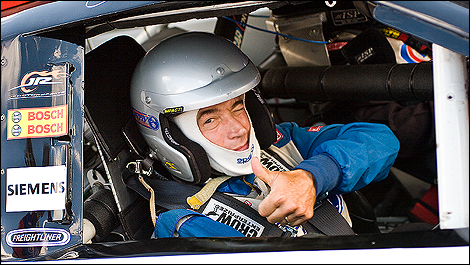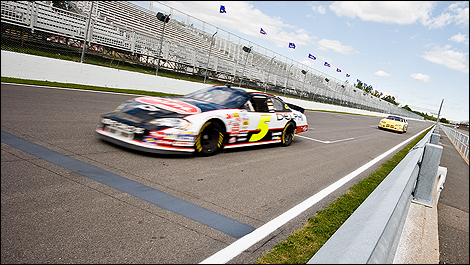Several members of the medias from Montreal, including Auto123.com, were invited on Wednesday to discover the reality of lapping the
Gilles Villeneuve circuit at speeds up to 270 km/h!
 |
| Photo: Maxime Allaire/Auto123.com |
Just a few days prior to the running of the
NAPA Auto Parts 200 Nationwide race, several medias from Montreal, including Auto123.com, were invited on Wednesday to discover the reality of lapping Gilles Villeneuve circuit at speeds up to 270 km/h!
The organisers of the race had booked the famed Richard Petty Driving Experience for this very special day. These are genuine Nationwide cars fitted with a passenger seat.
Wearing a Nomex suit, crash helmet and HANS device, I was snuggly strapped in the right-hand seat made of aluminum.
Switches on, contact. The big block V-8 comes to life with a terrifying, rumbling sound. The 3500-pound car vibrates like crazy.
First gear is selected, revs are up and we’re off! The first serious acceleration is breath taking. What a kick! The engine revs instantly jump to 6000. Gear changing is done in a blink of an eye.
On the back straightaway, the missile runs in fourth gear at 6000 rpm, reaching the speed of 270 km/h.
Braking is a delicate maneuver. It must be done in a straight line, unlike what’s done with most open wheelers. The drivers lifts his foot from the throttle and presses hard on the brake pedal, going down the gears at the same time. The braking zone is amazingly long. He then gradually turns the steering wheel to load the outside tires so they generate as much lateral grip as possible.
Just after the apex, the driver gets his foot back on the accelerator. The car jumps forward with a nice slide from the rear end. Cool!
After one full lap, the tires are up to operating temperature, and it shows. Cornering speeds are much higher than they were on the opening lap, and the car is much more stable.
 |
| Photo: Maxime Allaire/Auto123.com |

